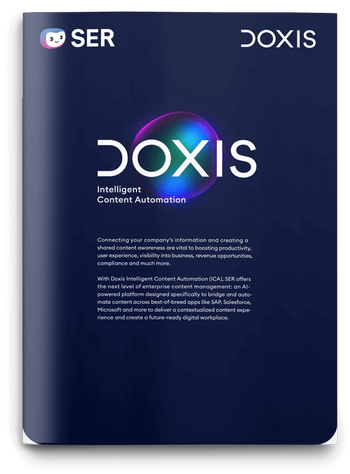SER Blog Innovation & Technology
From static rules to dynamic processing: AI's impact on Doxis ECM
| Steffen Wilhelm
We are entering a new phase in how we manage data within enterprise content management (ECM) systems. Since the public release of OpenAI and ChatGPT, a new approach to classification and data extraction has emerged. Language models are the hot topic and seem to be everywhere, which is no surprise given how fast they can comprehend and generate text, among other things. The potential for businesses is huge, which is like saying the sky is blue at this point. We’re all racing to find the best way to integrate it, but this space is to show you how we’re going to be using it for Doxis, from supporting our users in the future with their searches to bringing about about unprecedented extraction and classification quality.
We've been at this for a while now
You're in good hands, even if you're like the many businesses we serve who are inspired by the market to develop an AI approach but have no idea where to start. We get it. The topic is complex, and the options are many. But SER is committed to guiding you through this process. Recognized by analysts at Gartner, Forrester, and IDC, we are at the forefront of intelligent document processing and are experts in integrating powerful AI solutions.
And when it comes to AI, we implement a composable approach, which connects you with the AI model that best fits their specific needs instead of relying on a single solution. This strategy not only ensures security and flexibility but also allows for customized, use-case-specific models that can be fine-tuned to meet unique data requirements.
But while all that sounds good, what should you be thinking about before reaching for an AI-powered solution?

AI strategies: Where to start?
For many organizations, the first step in developing an AI strategy is to understand the potential applications within their existing systems. This includes identifying key areas where AI can add value, such as improving efficiency, reducing errors and gaining new insights. We could easily write a whole whitepaper on this, but generally, most enterprises follow a roadmap that looks a bit like this:
1. Evaluate current systems:
Review the tools and processes in place to identify inefficiencies, such as slow data processing or high error rates. Understanding your baseline is essential for meaningful improvements.
2. Identify key applications:
Determine specific areas where AI can enhance performance, including:
- Automating repetitive tasks like data entry or document classification to save time.
- Leveraging AI to enhance accuracy by minimizing manual input and ensuring consistent data handling.
- Using AI to analyze large datasets for patterns that can inform decision-making and strategic planning.
3. Engage stakeholders:
Collaborate with team members from various departments to gather input on challenges and opportunities. This ensures the AI strategy aligns with organizational goals.
4. Define objectives:
Set clear, measurable goals, such as reducing processing time by a certain percentage or decreasing error rates in data entry.
5. Research AI solutions:
Investigate different AI-powered solutions that best fit your identified needs, whether it’s simple machine learning for predictive analytics or natural language processing for automated customer interactions.
6. Conduct pilot tests:
Implement small-scale trials of selected AI solutions to assess their impact and gather feedback, allowing for adjustments before a full rollout.
Composable AI: Flexibility and adaptation
The concept of composable AI revolves around flexibility. Instead of being limited to a single AI model, organizations can choose from different models to best suit their specific needs. This is especially important because different use cases require different AI capabilities. For example, a model optimized for natural language processing might be ideal for document classification while another, which was developed for image recognition, is better suited for handling scanned documents.
A major advantage of composable AI is the ability to tailor models to specific data sets. This customization ensures that the AI model works optimally for the unique needs of the organization. By fine-tuning a model to your data, you can get greater accuracy and more relevant results, improving the overall performance and efficiency of your ECM system.

Doxis Intelligent Content Automation
With Doxis Intelligent Content Automation SER offers the next level of enterprise content management.
Read nowThe role of SER Group
SER Group is committed to guiding its customers through this transition. By providing a platform that supports the integration of various AI models, we provide the tools and expertise to effectively implement and use AI in ECM systems. This support includes not only the technical aspects but also strategic advice on selecting the right models for each application.
Implementing AI in an ECM system can have numerous practical benefits:
- AI can automatically sort and categorize documents, saving time and reducing human errors.
- Relevant information can be extracted from documents quickly and accurately, enabling faster decision-making processes.
- AI models can analyze large data sets to uncover patterns and insights that were previously hidden and provide valuable business intelligence.
The limitations of LLMs in enterprise content management
Large language models (LLMs), such as those used in enterprise content management (ECM), have impressive capabilities but also significant limitations. Understanding these is critical for organizations to use AI effectively.
Bad data, bad results:
First, LLMs rely heavily on large amounts of high-quality data. When we talk about fine-tuning a model based on your own data, the following applies: The better the data, the better the model will perform. However, if the data is poor or biased, these deficiencies will be reflected in the results, which can lead to inaccurate or biased outcomes and negatively impact decision-making processes.
High costs:
Another problem is the resource-intensive nature of LLMs. Training and deploying these models requires significant computing power, which can be costly. Not all organizations can afford the infrastructure required to maintain and update these models, resulting in additional operational costs. SER is working on a solution here.
Decisions lacking transparency:
Interpretability is also a major concern. LLMs operate as “black boxes,” making it difficult to understand how decisions are made. This lack of transparency can be an obstacle to trust, especially in critical areas where understanding the reasons behind decisions is crucial.
Contextual limitations:
Contextual constraints pose another challenge. LLMs excel at general language tasks but may struggle with context-specific applications. Without fine-tuning, they cannot fully capture the nuances of specialized areas, limiting their effectiveness in those areas.
Ethical and legal risks:
Ethical and legal concerns are of the greatest importance. Using AI requires users to navigate issues of data privacy, security, and bias. Ensuring that AI systems meet legal standards and do not reinforce existing biases is complex.
Human-in-the-loop maximizes benefits of AI:
Despite their capabilities, LLMs still require human oversight to ensure their output is accurate and relevant. This human intervention can reduce the efficiency gains expected from automation.

Executive Summary: Total Economic Impact™ study
Long-time customer SEW-EURODRIVE achieved a 336% ROI over a three-year period and a payback in less than six months. We have summarized the study results for you.
Read nowDoxis AI exploration package: A practical approach
One of the fascinating things about working with new technology is that you often don't realize how useful it can really be until you actually use it. This is especially true for AI. You can read all the articles and attend all the conferences, but until you see how it works for your specific problems, you haven't really understood it.
For customers interested in exploring the advanced capabilities of Doxis, the Doxis AI Exploration Package offers an exclusive early adopter experience. This package is carefully designed to provide you with a hands-on evaluation of Doxis AI, tailored to your specific application.
As part of the package, we will analyze your unique requirements with you, align the solution options with your goalsand implement the application in the test environment as far as possible. Your active participation is critical to the success of this initiative.
The paid components of the Doxis AI Exploration Package include:
- Workshop with an AI consultant:
Join us for several interactive sessions with one of our AI experts to explore potential applications and strategies. - Five person days of consulting/service:
Benefit from dedicated consulting and services to support the implementation and optimization of your application. - Providing a test system:
Access a test system for a set period of time that allows you to evaluate Doxis AI in a stand-alone environment.
We prepare the results for marketing purposes and make them available to you – anonymized upon request.
Interested? Send us a contact request and briefly describe your application without obligation. Our AI experts will contact you directly.
Note: To ensure quality, the number of companies we support at the same time is strictly limited. So it pays to act fast!

Steffen Wilhelm
Hello, my name is Steffen Wilhelm.
I have been working at SER as a Solution Engineer for two years, advising customers on digitization in the field of Enterprise Content Management. My focus is on Artificial Intelligence as well as the integration and resolution of use cases in this area.
Previously, I worked for five years at a start-up specializing in the processing and management of incoming invoices.
In addition to conducting workshops and presentations for customers, I create content in the form of articles, videos, and whitepapers. When the day ends and I have some time left, I enjoy riding my racing bike and exploring the beautiful surroundings of Vienna.
The latest digitization trends, laws and guidelines, and helpful tips straight to your inbox: Subscribe to our newsletter.
How can we help you?
+49 (0) 30 498582-0Your message has reached us!
We appreciate your interest and will get back to you shortly.




